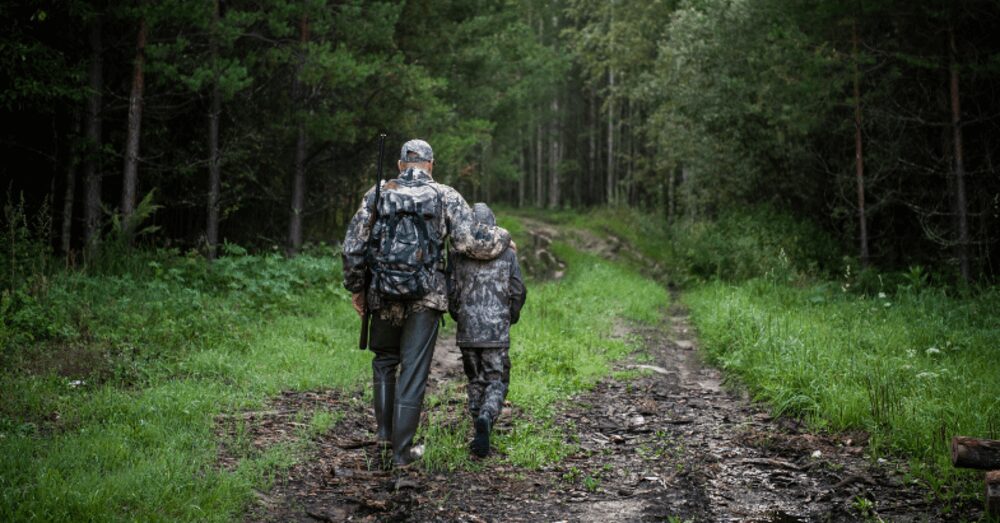Screen time is a huge problem, but getting kids into hunting and outdoors is a great way to get them away from screens and mobile devices.
American kids spend an average of 7.5 hours a day staring at screens for entertainment, but only four to seven minutes playing outside, according to research from the Kaiser Family Foundation and Child Mind Institute. That gap shows up in hunting participation numbers, too. While youth hunting saw a spike during the pandemic, jumping from 1.2 million kids aged 6 to 15 in 2020 to 1.8 million in 2021, many believe those numbers have dropped back as life returned to normal.
Getting kids into hunting and outdoors creates benefits of outdoor time vs screens
The problem goes beyond just hunting. All that screen time comes with real health consequences, including increased blood pressure, high blood sugar, poor sleep, anxiety, and depression. Time spent outdoors does the opposite, improving sleep quality, boosting immune systems, and reducing stress. Physical activity in nature also builds cardiovascular health and muscle strength. Getting kids interested in hunting starts with getting them comfortable outside first.
Youth hunting participation rates help in reducing children’s screen time
The approach works best when you trim screen time gradually rather than going cold turkey. Offer outdoor experiences frequently and build on each one. Take advantage of in-person classes that teach outdoor skills. When kids are ready, invite them along on actual hunts. The key is creating positive outdoor experiences that make kids want to come back. Make positive experiences from outdoor activities for kids and teens with beginner hunting trips with children that build into family hunting traditions.
Start young, if possible, but it’s never too late to shift a family’s culture away from screens and toward nature. Research shows that the more time kids spend outside, the more they ask to be there. That comfort in nature becomes the foundation for developing a genuine interest in hunting and other outdoor pursuits. The benefits extend beyond the individual, too. Introducing the next generation to hunting helps preserve outdoor traditions and conservation efforts that depend on hunter participation and funding.
Getting kids into hunting and outdoors through youth outdoor education programs
What do you see wherever you go? If you see kids fixated on screens, often in some type of trance, you see the problem. Sure, parents need some time with kids involved in activities so they can get things done around the house, but that doesn’t mean constant fixation on screens. What happened to kids being bored on car rides, playing car games with their parents, or singing along to old songs? What happened to noticing surroundings and the scenery? Kids who spend too much time on their screens develop health problems later on. It’s important to work on transitioning kids to nature, where they can feel more connected with the planet, the environment, and the animals that live in the wilderness areas around us.
When should you begin getting kids into hunting and outdoors?
You should always get your kids outdoors and teach them to play and enjoy time in nature without screens. When it comes to hunting, that is more of an individual subject, and it depends on the child and their attention span. Hunting isn’t just about killing an animal, although that is a big part of it, but it’s also about fitting into nature, learning about the environment, and learning patience while waiting for the animal to appear. It’s a great way to teach kids about where their food comes from, about the outdoors, about nature, and about life and death.
What if you don’t want to go hunting?
You don’t have to involve hunting in your lifestyle if it’s not something you’re familiar with. Getting kids into hunting and outdoors can simply be going outdoors, where you can teach them to begin hunting for various plants, bugs, and birds. This can involve taking photos of the area (although this means taking their phones), and it could be as simple as collecting leaves to identify later, or using them as decoration. Going outside is the most important part of getting outside and off screens to ensure children have the exposure they need to nature. Being comfortable outside allows your kids to learn about and develop an appreciation for nature that won’t come from hours of screen time.
What will you do to begin getting kids into hunting and outdoors? Are you ready to take some classes, learn about the nature in your area, and learn about the wildlife that surrounds you every day? Get ready to feel much better as you enjoy nature and spend time outside with your kids and away from their screens.

